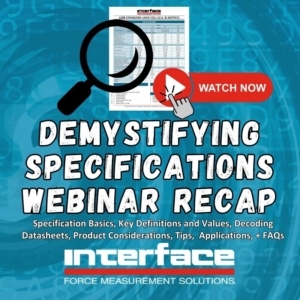Demystifying Specifications Webinar Recap

Interface recently hosted an online technical seminar that detailed product specification basics, key values, terms to know, how to read a datasheet, what specs matter most in force measurement applications.
For Interface, specifications are detailed descriptions that outline the characteristics, features, and qualities of our products, systems, or services. Product specifications are included on all datasheets, detailing product performance, capabilities, capacities and dimensions. Products have internal specifications that are tested against during manufacture, typically with full traceability.
Throughout the webinar Demystifying Specifications, Brian Peters and Jeff White offered important tips on what to consider for high-speed, durability, precision, and specialty product requirements. They highlighted what to look for on the product datasheet when choosing a load cell or instrumentation device. This includes variables in specifications related to expected performance of transducers and instrumentation based on frequency, environment, and other critical testing application considerations. They also answered the most frequently asked questions of our applications engineers related to specifications and datasheets.
Demystifying Specifications Webinar Topics
- Specification Basics
- Specifications and Values in Force Measurement
- Decoding Datasheets
- Detailing Product Specs for Load Cells
- Detailing Product Specs for Instrumentation
- Detailing Product Specs for Specialty Sensor Products
- Applying Specifications to Applications
- Specification Tips
- FAQs and Resources
The entire webinar, Demystifying Specifications, is now available to watch online.
Four Types of Specifications
Interface provides four types of specifications for every product we make and sell: functional, technical, performance and design.
- Functional specifications describe the intended functionality or behavior of a product, whether a sensor, instrument or accessory. They outline what the product or system should do and how it should perform its tasks. Functional specifications typically include applications, product requirements, and expected use case results.
- Technical specifications provide detailed information about mechanical aspects of a product or system. They may include information about the materials, dimensions, technical standards, performance criteria, capacities, and other technical details necessary for the design, development, and implementation of the product or system
- Performance specifications define the performance requirements and criteria that a product or system must meet. This is critical in force and measurement. They specify the desired performance levels, such as speed, accuracy, capacity, efficiency, reliability, or other measurable attributes. Performance can be defined by a specific range, with maximum standards for peak performance. Performance specifications help ensure that the product or system meets the desired test and measurement goals.
- Design specifications outline the specific design criteria and constraints for a product or system. These specs provide guidelines and requirements related to the visual appearance and can also reference the model details found in a product’s engineering CAD STEP file.
 Specifications Commonly Found on Interface Product Datasheets
Specifications Commonly Found on Interface Product Datasheets
- Models based on Form Factor
- Measuring Range (Capacity)
- Measurement Units: US (lbf) Metric (N, kN)
- Accuracy (Max Error)
- Temperature: Operating Range, Compensated Range, Effect on Zero and Effect on Output (Span)
- Electrical: Rated Output, Excitation Voltage, Bridge Resistance, Zero Balance and Insulation Resistance
- Mechanical: Safe Overload, Deflection, Optional Base, Natural Frequency, Weight, Calibration and Material
- Dimensions
- Options
- Connector Options
- Accessories
Key Force Measurement Specification Terms to Know
Nonlinearity: The algebraic difference between OUTPUT at a specific load and the corresponding point on the straight line drawn between minimum load and maximum load. Normally expressed in units of %FS.
Hysteresis: The algebraic difference between output at a given load descending from maximum load and output at the same load ascending from minimum load. Normally expressed in units of %FS.
Static Error Band (SEB): The band of maximum deviations of the ascending and descending calibration points from a best fit line through zero output. It includes the effects of nonlinearity, hysteresis, and non-return to minimum load. Expressed in units of %FS. SEB Output is a best fit straight line output at capacity.
Nonrepeatability: The maximum difference between output readings for repeated loadings under identical loading and environmental conditions. Expressed in units of %RO. In practice there are many factors that affect repeatability that ARE NOT included in the nonrepeatability specification.
Creep: The change in load cell signal occurring with time, while under load and with all environmental conditions and other variables remaining constant. Expressed as % applied load over specific time interval. Logarithmic effect that is also symmetric on load removal. Stated specifications may differ and are not for the same time interval.
Eccentric and Side Load Sensitivity: Eccentric Load – Any load applied parallel to but not concentric with the primary axis. Results in moment load. Side Load – Any load at the point of axial load application at 90° to the primary axis. Error influences are reported in terms % and %/in.
Watch the event to understand why these specification details matter and some of the important variables to consider when comparing, using or troubleshooting different measurement products. During the event, we provided a list of resources that are helpful when looking for specification information or definitions. The complete list is below.
ADDITIONAL RESOURCES
Interface Product Selection Guides
Interface Technical Support Information and Troubleshooting
Interface Load Cell Field Guide (Free Copy)
Interface Installation Guides and Operation Manuals
Interface Software and Drivers
Interface 101 Blog Series and InterfaceIQ Posts









